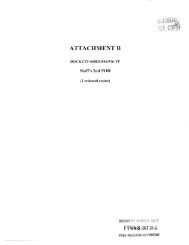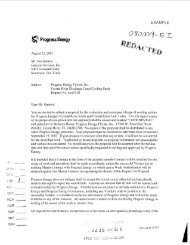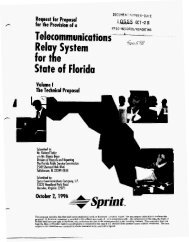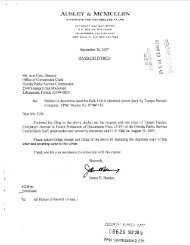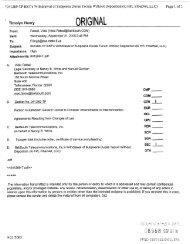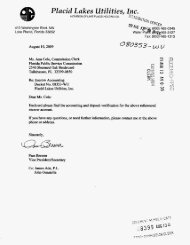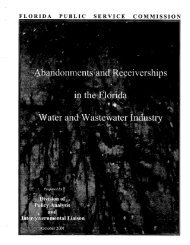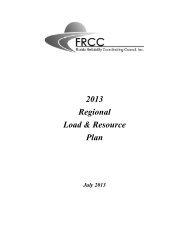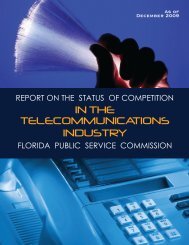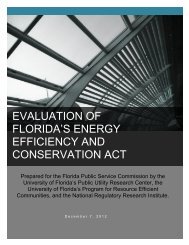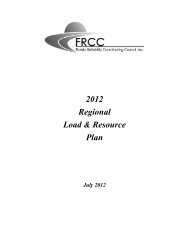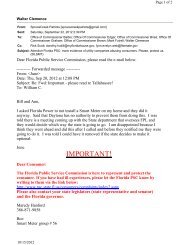Distribution System Improvement Charges - Public Service ...
Distribution System Improvement Charges - Public Service ...
Distribution System Improvement Charges - Public Service ...
Create successful ePaper yourself
Turn your PDF publications into a flip-book with our unique Google optimized e-Paper software.
<strong>Distribution</strong> <strong>System</strong> <strong>Improvement</strong> <strong>Charges</strong><br />
for the<br />
Florida Water and Wastewater Industry<br />
PREPARED BY:<br />
Division of Policy Analysis & Intergovernmental Liaison<br />
October 2001
TABLE OF CONTENTS<br />
I .<br />
I1 .<br />
I11 .<br />
IV .<br />
V .<br />
VI .<br />
VI1 .<br />
VI11 .<br />
IX .<br />
INTRODUCTION ...................................................... 1<br />
PENNSYLVANIA ...................................................... 1<br />
ILLINOIS ............................................................. 8<br />
INDIANA ............................................................ 11<br />
NEWYO RK .......................................................... 12<br />
CONNECTICUT ...................................................... 15<br />
FLORIDA ............................................................ 15<br />
CONCLUSION ....................................................... 17<br />
ATTACHMENTS ..................................................... 20<br />
i
<strong>Distribution</strong> <strong>System</strong> <strong>Improvement</strong> <strong>Charges</strong><br />
I. INTRODUCTION<br />
The need to replace aging infrastructure is a serious and costlyproblem being faced by many<br />
water and wastewater utilities throughout the United States. Many of the dnnking water systems<br />
in the United States were built at the turn of the century and need to be replaced or improved by<br />
cleaning and relining. Although many of Florida’s systems are only 20 or 30 years old, they face<br />
similar problems with deteriorating infrastructures. Aged and deteriorated water mains can result<br />
in poor service for customers due to increased main breaks, frequent service interruptions, low<br />
pressure, discolored water, threatened water quality, inadequate fire protection, and greater<br />
unaccounted for water.<br />
As with most things, the cost of infrastructure replacement has increased significantly over<br />
the years. For example, in 1900 the cost to install one foot of main was $1. The cost to replace one<br />
foot of main today is approximately $100. The cost to clean and reline one foot of main is<br />
approximately $61. In 1996, the U.S. Environmental Protection Agency (EPA) determined that the<br />
infrastructure investment needed nationwide over the next 20 years is $138.4 billion. Of that total,<br />
$77.2 billion is needed just for transmission and distribution systems. The magnitude of needed<br />
replacements is so great that traditional rate making methodologies are unlikely to enable<br />
infrastructure improvements on a large enough scale at a rate that is affordable for ratepayers, and<br />
sufficient federal funding is not available to fill the gap.<br />
A few states, including Pennsylvania, Illinois, Indiana, and New York, have implemented<br />
mechanisms to address the growing need for utilities to replace aging infrastructure. While a<br />
majority of the discussion herein centers on distribution systems, the <strong>Distribution</strong> <strong>System</strong><br />
<strong>Improvement</strong> Charge (DSIC) can also be readily used for collection system improvements which<br />
are often more costly than water distribution improvements. This report briefly describes the<br />
mechanisms each of these states has in place as well as those that have been discussed in<br />
Connecticut and Florida.<br />
11. PENNSYLVANIA<br />
Pennsylvania determined that $2.9 billion of transmission and distribution remediation was<br />
needed over the next 20 years. In order to address this need, the Pennsylvania <strong>Public</strong> Utility<br />
Commission (PPUC) developed the <strong>Distribution</strong> <strong>System</strong> <strong>Improvement</strong> Charge (DSIC).<br />
Pennsylvania was the first state to implement this type of surcharge to enable remediation of the<br />
water distribution system infrastructure.<br />
1
History of Pennsylvania’s DSIC<br />
Section 1307 of Pennsylvania’s Statutes authorizes the PPUC to prescribe a mandatory<br />
system for automatic adjustment of a utility’s rates, by means of a sliding scale of rates or other<br />
method. Although Section 1307 was typically used as authority for automatic rate adjustments for<br />
fuel costs of electric and gas utilities, it had also been used on occasion for certain state taxes and<br />
PENNVEST repayment. (PENNVEST is the Pennsylvania Infrastructure Investment Authority,<br />
which is an independent agency that offers an innovative approach to financing local clean water<br />
infrastructure projects. PENNVEST provides low-interest loans and grants to fund local water,<br />
wastewater, and stormwater projects.)<br />
In 1996, under the provisions of Section 1307, two utilities petitioned the PPUC for approval<br />
to file an automatic adjustment charge tariff to establish a DSIC. A formal complaint was filed by<br />
the Office of Consumer Advocate, the Pennsylvania equivalent of Florida’s Office of <strong>Public</strong><br />
Counsel. The PPUC approved the petition on August 22, 1996, and the Office of Consumer<br />
Advocate subsequently filed an appeal.<br />
While the appeal was pending in Commonwealth Court, an amendment was introduced in<br />
the Pennsylvania Legislature to add a provision to Section 1307 of the <strong>Public</strong> Utility Code. The<br />
amendment specifically provided for the allowance of an automatic adjustment charge for<br />
infrastructure remediation. The Legislature approved the bill, and Governor Tom Ridge signed the<br />
bill into law on December 18,1996. The revised statute was implemented in 1997. Section 1307(g)<br />
of the Pennsylvania Statutes states:<br />
Recovery of costs related to distribution system improvement projects designed<br />
to enhance water quality, fire protection reliability and long-term system<br />
viability.--Water utilities may file tariffs establishing a sliding scale of rates or other<br />
method for the automatic adjustment of the rates of the water utility as shall provide<br />
for recovery of the fixed costs (depreciation and pretax return) of certain distribution<br />
system improvement projects, as approved by the commission, that are completed<br />
and placed in service between base rate proceedings. The commission, by regulation<br />
or order, shall prescribe the specific procedures to be followed in establishing the<br />
sliding scale or other automatic adjustment method.<br />
For clarification, the phrase “base rate proceedings” in the Pennsylvania Statute is what is referred<br />
to in Florida as a rate case or full rate proceeding. Pennsylvania was the first state to enact a law<br />
that enables water utilities to recover costs that are related to water utility improvement projects.<br />
The PPUC subsequently approved a DSIC for four utilities, which will be discussed in more detail<br />
later.<br />
Definition & Purpose of Pennsylvania’s DSIC<br />
The DSIC blends the concepts of a surcharge and an automatic adjustment charge. A<br />
surcharge establishes a mechanism for cost recovery outside of the utility’s basic revenue<br />
2
equirement. In other words, a surcharge will allow recovery of a cost that was not previously<br />
included in the utility’s rates. Also, surcharges often are defined for a specific purpose and time<br />
frame. The DSIC is a surcharge that allows the recovery of costs related specifically to distribution<br />
system improvement projects designed to enhance water quality, fire protection reliability and longterm<br />
system viability. The projects are typically ongoing, but short-term in nature.<br />
An automatic adjustment charge enables a utility to recover costs between rate cases.<br />
Otherwise, utilities are unable to earn a return on infrastructure replacement projects until their next<br />
rate case, but they will continue to incur depreciation expense. The automatic adjustment charge<br />
helps to mitigate the impact of regulatory lag on the utilities’ recovery of those costs.<br />
The PPUC has stated that the purpose of the DSIC is to: (1) recover the fixed costs<br />
(depreciation and pretax return) of certain nonrevenue producing, non expense reducing distribution<br />
system improvement projects completed and placed in service between rate cases; (2) provide the<br />
utility with the resources to accelerate the replacement of aging, water distribution infrastructure in<br />
order to comply with evolving regulatory requirements imposed by the Safe Drinking Water Act<br />
(SDWA); and (3) develop and implement solutions to regional water supply problems. Although the<br />
mechanisms employed by other states may go by a different name, they are all defined similarly and<br />
serve the same purpose.<br />
Benefits of Pennsylvania’s DSIC<br />
The PPUC believes the benefits of the DSIC are that it:<br />
e<br />
enables utilities to accelerate infrastructure remediation;<br />
enables utilities to recover infrastructure remediation costs on a quarterly basis rather<br />
than waiting until the next rate case; and<br />
makes projects more affordable for both utilities and ratepayers.<br />
For example, if a utility has 5,600 miles of mains that it is currently able to rehabilitate at<br />
a rate of 25 to 30 miles each year, it would require between 185 and 225 years to make all of the<br />
needed improvements to the existing facilities. Under traditional rate making, an attempt to<br />
accelerate the remediation rate from 200 years down to 75 years would triple customers’ rates.<br />
However, allowing for recovery of the DSIC project costs in small increments without the necessity<br />
for a full rate proceeding enables the utility to make the replacements at a faster pace and at a lower<br />
cost to the customers.<br />
Simply stated, the bottom-line benefit of the DSIC is that it enables utilities to provide<br />
improved service to customers sooner. The direct customer benefits resulting from accelerated<br />
system remediation include improved water quality, improved fire protection, increased pressure,<br />
fewer service interruptions, and more time between rate cases, leading to greater rate stability and<br />
lower rate case expense.<br />
3
Implementation of Pennsylvania ’s DSIC<br />
Under Section 1307 of the Pennsylvania Statutes, a utility may request approval of the DSIC<br />
through a tariff filing. The new tariff filing must provide for a notice period of at least 60 days to<br />
allow sufficient time for staff review of the proposed tariff. Once the DSIC becomes effective,<br />
subsequent quarterly updates may be filed on 10 days notice.<br />
The following property is eligible for the DSIC:<br />
0<br />
services, meters, and hydrants installed as in-kind replacement for customers;<br />
0<br />
mains and valves installed as replacements for existing facilities that have worn out,<br />
are in deteriorated condition, or mandated upgrades;<br />
0<br />
main extensions installed to eliminate dead ends and to implement solutions to<br />
regional water supply problems that have been documented as presenting a<br />
significant health and safety concern for customers currently receiving service from<br />
the utility or the acquired utility;<br />
0<br />
main cleaning and relining projects; and<br />
0<br />
un reimbursed funds related to capital projects to relocate utility facilities due to<br />
highway relocations.<br />
The DSIC-eligible property items are recorded in the appropriate accounts under that<br />
Commission’s prescribed accounting system, such as the National Association of Regulatory Utility<br />
Commissioners (NARUC) Uniform <strong>System</strong> of Accounts (USOA).<br />
In essence, the DSIC is intended to be limited to revenue-neutral infrastructure projects,<br />
consisting principally of replacement investments in so-called “mass property” accounts. Items that<br />
are specifically excluded from DSIC-eligibility are the costs of extending facilities to serve new<br />
customers, and projects receiving PENNVEST funding.<br />
The initial DSIC is calculated to recover the fixed costs of eligible plant additions that have<br />
not previously been reflected in the utility’s rate base and will be placed into service within one<br />
month prior to the effective date of the initial DSIC. Thereafter, the DSIC is updated on a quarterly<br />
basis to reflect eligible plant additions placed in service during the three-month periods ending one<br />
month prior to the effective date of each DSIC update. To illustrate, assume that the initial DSIC<br />
will become effective January 1 , 2001. The initial DSIC will reflect the fixed costs of eligible plant<br />
additions occurring fiom the date the utility’s rate base was last established through November 30,<br />
2000 (i.e., one month prior to the initial DSIC effective date of January 1,2001).<br />
4
The subsequent DSIC updates would occur as follows:<br />
Effective Date<br />
Of Change<br />
April 1,2001<br />
July 1,2001<br />
October 1,2001<br />
January 1,2002<br />
Date to which DSIC-Eligible<br />
Plant Additions Reflected<br />
February 28,2001<br />
May 30,2001<br />
August 31,2001<br />
November 30,2001<br />
The utility would continue to follow this schedule until its next rate proceeding or when it meets one<br />
of the criteria that requires cancellation of the DSIC. Those criteria will be discussed in more detail<br />
later.<br />
The fixed costs of DSIC projects consist of depreciation and pretax return. The PPUC has<br />
specified that the depreciation expense will be calculated by applying to the original cost of DSICeligible<br />
property the annual accrual rates employed in the utility’s last rate case for the plant<br />
accounts in which each retirement unit of DSIC-eligible property is recorded.<br />
Additionally, the PPUC has specified that the pretax return will be calculated using the state<br />
and federal income tax rate, the utility’s actual capital structure and actual cost rates for long-term<br />
debt and preferred stock as of the last day of the three-month period ending one month prior to the<br />
effective date of the DSIC and subsequent updates. The cost of equity will be the equity return rate<br />
approved in the utility’s last fully-litigated rate proceeding for which a final order was entered not<br />
more than two years prior to the effective date of the DSIC. If more than two years have elapsed<br />
between the entry of the final order and the effective date of the DSIC, the equity return rate used<br />
in the calculation will be the equity return rate calculated by the PPUC staff in the latest Quarterly<br />
Report on the Earnings of Jurisdictional Utilities released by the PPUC.<br />
The PPUC developed sample tariff language to be used for DSICs. The sample tariff<br />
language was designed to fully explain the DSIC computation, including a listing of DSIC eligible<br />
property and related account numbers, so that in future years the purpose and intent of the DSIC<br />
surcharge will be apparent from reading only the tariff supplement. Much of the information<br />
discussed above is on the sample tariff, which is shown as Attachment A of this report.<br />
The DSIC surcharge is expressed as a percentage carried to two decimal places and is<br />
applied to the total amount billed to each customer under the utility’s otherwise applicable rates and<br />
charges, excluding amounts billed for public fire protection service and the State Tax Adjustment<br />
Surcharge. The formula used to calculate the DSIC is shown on page 3 of Attachment A.<br />
5
Mon it0 ring Pennsylvania ’s DSIC<br />
Many of the objections to the DSIC involve customer protection. In order to protect<br />
ratepayers, the PPUC has established several safeguards. First, as discussed above, utilities may<br />
request approval of a DSIC as a tariff filing. The tariff filing procedures allow protest of the tariff<br />
filing from affected parties. That is the first level of customer protection. Second, in order to protect<br />
the ratepayers after a DSIC is implemented, the PPUC has established safeguards such as a noticing<br />
requirement, a limit on eligible plant, a used and useful requirement, a cap on the surcharge, an<br />
annual audit, and customer refunds in the event of over earnings. Also, the surcharge is reset to zero<br />
in the utility’s next rate case or if the utility over ems.<br />
Regarding customer noticing, the PPUC requires that an explanatory bill insert be included<br />
with the first billing of the DSIC. Thereafter, the utility must notify customers of changes in the<br />
DSIC (e.g., quarterly update of DSIC) by including appropriate information on the first bill that they<br />
receive following any change.<br />
Some opponents of the DSIC believe it provides utilities with a way to circumvent the<br />
detailed review that the rate base would receive in a full rate proceeding. The PPUC has addressed<br />
that concern in several ways, the first of which is to limit the type of property that is eligible to be<br />
recovered through the DSIC as previously discussed. Further, in order to avoid any potential<br />
violation of the “used and useful” rule, each surcharge period is limited to reflect only those costs<br />
of eligible plant additions that are actually placed in service during the three-month period ending<br />
one month prior to the effective date of the DSIC upgrade. Finally, the PPUC imposed a 5% cap<br />
on the surcharge. The maximum amount allowed for any DSIC is 5% of billed revenues. The PPUC<br />
believes the price cap will ensure that the utility cannot avoid a full rate review indefinitely. In other<br />
words, the DSIC will provide the utility with needed resources to accelerate infrastructure<br />
remediation, but will not provide a sufficient increase in revenues to permanently avoid a full rate<br />
case.<br />
As an additional safeguard, an audit will be conducted on an annual basis for reconciliation<br />
of the difference between revenues and costs. If revenues exceed eligible costs, over collections will<br />
be refunded to the customers with interest. Under collections will be billed in future rates without<br />
interest recovery. Further, the rate will be reset to zero under several circumstances. When the<br />
utility has its next rate case, the plant items covered by the DSIC will be placed in the utility’s rate<br />
base. This results in those costs being recovered through the normal service rates on a goingforward<br />
basis. In order to prevent double recovery of those costs, they must be removed from the<br />
DSIC. Consequently, the DSIC will be reset to zero at that time. Additionally, if the utility’s earned<br />
rate of return exceeds its allowable rate of return as determined in its last rate case, the charge will<br />
be reset to zero.<br />
6
Effectiveness of Pennsylvania’s DSIC<br />
In the 1998 National Association of Water Companies Pennsylvania Forum, Commissioner<br />
Norma Mead Brownell of the Pennsylvania <strong>Public</strong> Utility Commission stated that the DSIC<br />
provoked little consumer reaction and resulted in infrastructure investment that otherwise would not<br />
have occurred. In Pennsylvania, four utilities have implemented a DSIC thus far. As previously<br />
discussed, rehabilitating a utility’s distribution system at a rate of 20 to 30 miles per year may take<br />
more than 200 years to replace all the facilities. Pennsylvania has experienced the following<br />
changes in the remediation rate since implementation of the DSIC:<br />
Utility # 1 :<br />
0<br />
Before DSIC: 1995 - 14 miles completed; entire system would require 246 years<br />
0<br />
After DSIC: Since 1997 - 23 miles completed annually; entire system can be completed in<br />
150 years<br />
Utility #2:<br />
0<br />
Before DSIC: 1995 - DSIC-type projects - $1.2 million<br />
0<br />
After DSIC: 1998 - DSIC investment - $1.7 million<br />
0<br />
Projected 2000 - DSIC investment - $2.5 million<br />
0<br />
Projected 2001 - DSIC investment - $2.7 million; 117 years to complete entire system at this<br />
rate<br />
Utilitv #3:<br />
0<br />
Before DSIC: 27 miles completed annually; entire system would require 225 years<br />
0<br />
First Year of DSIC: 42 miles completed; entire system would require 178 years at this rate<br />
0<br />
Second Year of DSIC: 46.6 miles completed; entire system would require 163 years at this<br />
rate<br />
Utility #4:<br />
0<br />
After DSIC: Five-fold increase in main projects<br />
It should be noted that these four utilities vary greatly in size. For example, the plant-inservice<br />
ranges from $95 million to $1.4 million. However, it is clear that in each instance the rate<br />
of system remediation improved after implementation of the DSIC. The PPUC believes the DSIC<br />
is an ideal mechanism to accelerate infrastructure remediation.<br />
Overall, the DSIC makes water distribution improvement projects more affordable for water<br />
customers at a substantially faster pace. The average monthly residential DSIC rates in<br />
Pennsylvania ranged from $.03 to $1.42. The PPUC believes this is a low charge with a high value.<br />
Finally, the PPUC believes the DSIC is a cost-effective way to facilitate infrastructure replacement,<br />
and is in the public interest.<br />
7
111. ILLINOIS<br />
In response to legislation, the Illinois Commerce Commission (ICC) is in the process of<br />
developing a surcharge mechanism called the Qualifymg Infrastructure Plant Surcharge (QIP) which<br />
closely resembles the Pennsylvania DSIC.<br />
History<br />
Illinois’ QIP was lobbied through the legislature in 1999 by Consumers Illinois Water<br />
Company (CIWC), which is a subsidiary of Philadelphia Suburban Corporation (PSC), the nation’s<br />
second largest investor-owned water utility, serving approximately 150,000 residents in Illinois.<br />
PSC operates water utilities in Pennsylvania, Ohio, New Jersey and Maine. CIWC claimed that<br />
similar legislation passed in Pennsylvania enabled the company to reduce the replacement of its<br />
aging water mains from a 500-year replacement cycle to a 100-year time frame. The ICC did not<br />
take a position regarding the proposed legislation. The Illinois legislature enacted Section 9-220.2<br />
of the Statutes that allowed the ICC to authorize a surcharge to encourage regulated water or sewer<br />
utilities to accelerate replacement of qualifymg infrastructure plant. The ICC is currently in the<br />
process of developing rules to implement the QIP. In March, 2001, the ICC concluded a workshop<br />
on its proposed rule to implement the QIP. Information contained within this report is from a draft<br />
rule and therefore subject to modification.<br />
Benefits of Illinois’ QIP<br />
The cosponsor of the bill stated the hope that the ICC, “will quickly develop regulation that<br />
will give incentives to water utilities to replace aging infrastructure at a more aggressive pace.” He<br />
further stated, “the model legislation has worked well in other states and after carefbl consideration<br />
by the Illinois legislature, we believe it will be good for jobs, good for firefighters and good for the<br />
customers.’’<br />
Implementation of Illinois ’ QIP<br />
The QIP is a surcharge which is applied to the bills of water and wastewater customers in<br />
the rate zone in which improvements are made. Customers are grouped into various rate zones,<br />
served under different rates, dependent upon their location. Therefore, the surcharge is applicable<br />
only to customers in areas in which improvements are made, and not spread over the utility’s entire<br />
service area.<br />
Like Pennsylvania, the purpose of the QIP is to recover the fixed costs of certain nonrevenue<br />
producing, non expense reducing eligible plant additions. The fixed costs recovered through the QIP<br />
are the pretax retum on the net additions and the net depreciation expense applicable to the<br />
additions.<br />
8
To be classified as QIP, plant additions must meet the following criteria:<br />
Such in-kind replacements are installed to replace facilities that are wom out or in<br />
deteriorated condition.<br />
Such in-kind replacements are installed after the conclusion of the test year in the<br />
utility’s latest rate case.<br />
Such in-kind replacements were not included in the rate base in the utility’s last rate<br />
case.<br />
The plant additions must be in-kind replacements of existing plant items from the<br />
accounts listed for water utilities and sewer utilities.<br />
Such in-kind replacements are nonrevenue producing and non expense reducing.<br />
For water utilities, the plant additions may include items from the following accounts:<br />
<strong>Service</strong>s;<br />
Meters and Meter Installations;<br />
Hydrants; and<br />
Transmission and <strong>Distribution</strong> Mains<br />
For wastewater utilities, the plant additions may include items fiom the following<br />
accounts:<br />
Collecting Sewers - Force;<br />
Collecting Sewers - Gravity; and<br />
<strong>Service</strong>s to Customers.<br />
In addition to in-kind replacements, qualifjmg mains also include main extensions to<br />
eliminate dead ends. Additionally, the un reimbursed costs associated with relocations of mains,<br />
services, and hydrants occasioned by street or highway construction can be included in the<br />
appropriate accounts.<br />
Monitoring Illinois ’ QIP<br />
In order to protect ratepayers, the ICC has proposed several safeguards to limit the level of<br />
the surcharge and adjust the surcharge based upon either over eamings or inclusion of<br />
improvements included within the QIP in rate base in subsequent rate proceedings.<br />
Cap: The QIP is capped at 5% of the base rates billed to customers.<br />
New Base Rates: The charge is reset at zero on the effective date of new base rates that<br />
provide for the recovery of the annual costs that had previously been recovered under the QIP.<br />
Earning Reports: The QIP will be adjusted if data filed with the ICC in the utility’s most<br />
recent quarterly earnings report shows that the utility, during the preceding twelve months, earned<br />
a rate of retum that exceeded the authorized rate of retum on the rate base approved by the ICC in<br />
9
the utility’s last rate case. If the utility’s rate of return for the preceding twelve months, from the<br />
earnings report that excludes revenues resulting from the QIP, exceeds that authorized rate of return<br />
on the rate base approved by the ICC in the utility’s last rate case, the QIP will be reset at zero. If<br />
the utility’s rate of return for the preceding twelve months, from the earnings report that includes<br />
revenues resulting from the QIP, exceeds the authorized rate of return on the rate base approved by<br />
the ICC in the utility’s last rate case, the utility will adjust the QIP so that the earnings of the next<br />
quarter, based upon revenues including the QIP, will not exceed the authorized rate of return on rate<br />
base approved by the ICC in the utility’s last rate case.<br />
Customer Notice: The Illinois <strong>Public</strong> Utility Act requires that a utility provide notice to<br />
customers for each change in rates. Therefore, an explanatory bill insert will be included with the<br />
initial billing of a QIP. The proposed rule requires the QIP to be shown as a separate line item on<br />
customer bills and the resulting revenue to be recorded in a separate revenue sub account.<br />
The proposed rule also requires that a utility makes an initial filing. The percentage of the<br />
initial QIP must be filed on an information sheet. The QIP must be updated on a quarterly basis to<br />
reflect eligible plant additions placed in service during the three-month periods ending one month<br />
prior to the effective date of each QIP update. The changes in the QIP rate will occur as follows:<br />
Effective Date Date to Which QIP Eligible<br />
Of Change Plant Additions Reflected<br />
April 1 February 28/29<br />
July 1 May 31<br />
October 1 August 31<br />
January 1 November 30<br />
The information sheet and supporting data for each quarterly update should be filed with the ICC<br />
no later than the 20th day of the month preceding the effective date of the change. An information<br />
sheet and supporting data filed after that date, but prior to the effective date, will be accepted only<br />
if it corrects an error or errors from a timely filed report for the same effective date. Any other<br />
information sheet and supporting data will be accepted only if submitted as a special permission<br />
request to become effective on less than 45 days notice.<br />
Based upon the proposed rule, the utility would file the following information with the ICC<br />
for the initial filing and each quarterly filing:<br />
e<br />
e<br />
e<br />
e<br />
A calculation of the QIP, pretax return, and gross revenue conversion factor;<br />
A detailed schedule showing the QIP eligible projects closed to utility plant. This<br />
schedule will provide the plant account number and title, category ofproject, project<br />
name, project description, work order number, dollar amount in the month of closing,<br />
and the month and year of closing for each QIP eligible project;<br />
A detailed schedule showing the calculation of depreciation expense; and<br />
The utility’s most recent quarterly earnings report for the rate zone showing the<br />
utility’s earnings for the preceding twelve months as well as a calculation of the rates<br />
of return for the preceding twelve-month period.<br />
10
Costs recoverable through the QIP include the pretax retum on the QP and the net<br />
depreciation expense applicable to the QIP. The pretax retum is calculated using the weighted<br />
cost(s) of equity determined in the utility’s last rate case. The weighted cost(s) of equity is<br />
multiplied by the gross revenue conversion factor (GRCF). The product(s) is then added to the<br />
weighted cost(s) of debt to obtain the pretax return. The pretax return is calculated using the<br />
formula shown on Attachment B.<br />
Effectiveness of Illinois’ QIP<br />
The QIP is not in effect pending final rule approval.<br />
IV.<br />
INDIANA<br />
The Indiana Utility Regulatory Commission (IURC) has implemented a <strong>Distribution</strong> <strong>System</strong><br />
<strong>Improvement</strong> Charge (DSIC) model that is similar to the one Pennsylvania developed to enable<br />
remediation of the water distribution system infrastructure.<br />
History of Indiana’s DSIC<br />
On July 1,2000, Indiana enacted legislation to establish the DSIC mechanism in Indiana.<br />
The legislation is similar to that previously enacted in Pennsylvania.<br />
Benefits of Indiana’s DSIC<br />
Indiana’s DSIC is designed for the replacement of aged infrastructure without the necessity<br />
of filing for general rate increases that would substantially increase costs to customers and delay<br />
such undertakings. The DSIC enables utilities to accelerate infrastructure remediation and recover<br />
remediation cost annually rather than waiting until the next rate case. This will make projects more<br />
affordable for both utilities and ratepayers. It will improve water quality, enhance fire protection<br />
and public safety as well by the replacement of pipelines.<br />
Implementation of Indiana’s DSIC<br />
Pursuant to the Indiana Code, a public utility providing water service may file with the<br />
Commission rate schedules establishing a DSIC that will allow the automatic adjustment of the<br />
public utility’s basic rates and charges to provide for recovery of DSIC costs. However, the public<br />
utility may not file a petition under this section in the same calendar year in which it has filed a<br />
request for a general increase in basic rates and charges. In addition to the Commission, the utility<br />
is required to serve the Office of the Utility Consumer Counselor (OUCC) a copy of its filing.<br />
<strong>Public</strong>ation of notice of the filing is not required. When a petition is filed, the Commission must<br />
conduct a hearing and issue its order within 60 days. The OUCC may examine the utility’s<br />
information to confirm that the system improvements are in accordance with the statute, to confirm<br />
proper calculation of the proposed change, and to submit a report to the Commission not later than<br />
thirty days after the petition is filed.<br />
11
Monitoring Indiana ’s DSIC<br />
Pursuant to the Code, at the end of each twelve-month period the DSIC charge is in effect,<br />
the public utility is required to reconcile the difference between DSIC revenues and DSIC costs<br />
during that period and recover or refund the difference, as appropriate, through adjustment of the<br />
charge by using procedures approved by the Commission.<br />
Effectiveness of Indiana’s DSIC<br />
At this time, two of Indiana’s largest companies are prevented from seeking recovery<br />
through a DSIC, due to rate settlements. Another company, Aquasource, Inc., applied for recovery<br />
through the DSIC, but later withdrew its request. At this time, no company in Indiana is using the<br />
DSIC recovery mechanism. Therefore, it is impossible to determine its effectiveness in speeding up<br />
replacement of aging water utility infrastructure.<br />
Of interest is Aquasource’s apparent reason for withdrawing its application. Although<br />
Aquasource would not divulge its reasons for withdrawal, it appears, based on a letter to the Florida<br />
Commission staff, that it may have been partially due to a difference in its interpretation of a phrase<br />
in the statute. The controversial phrase reads:<br />
The commission may not approve a DSIC to the extent it would produce total DSIC<br />
revenues exceeding five percent (5%) of the public utility’s base revenue level<br />
approved by the commission in the public utility’s most recent general rate<br />
proceeding.<br />
Aquasource interprets the phrase “base revenue level approved by the commission in the public<br />
utility’s most recent general rate proceeding,” to mean the rates approved in the last general rate case<br />
as applied to current billing determinants or current base revenue levels. The OUCC interprets the<br />
phrase to mean the actual base revenue level approved in the last rate case proceeding. Thus, the<br />
Indiana OUCC believed Aquasource was requesting considerably more than the statute entitled<br />
them. In its letter, Aquasource stated that because the proceeding was shaping up to be adversarial,<br />
it would not be concluded without considerable time and cost. Aquasource further pointed out that,<br />
...any legislation or rules should be clear how the DSIC should be applied.<br />
Otherwise, the intent of the legislation for an increase in low cost/abbreviated<br />
proceedings and small incremental rate impacts may be lost and the exact opposite<br />
may occur, i.e. an increase in costly/extended general rate proceedings resulting in<br />
higher rate impacts.<br />
V. NEWYORK<br />
The New York <strong>Public</strong> <strong>Service</strong> Commission (NYPSC) approved recovery of United Water<br />
New Rochelle’s requested Long Term Main Renewal Project (LTMRP) through a surcharge similar<br />
to that approved by the states previously discussed.<br />
12
United Water New Rochelle is a wholly owned subsidiary of United Water Works Inc.,<br />
which, in turn, is wholly owned by United Water Resources Inc. The operating company is almost<br />
110 years old and operates in 1 1 municipalities in Westchester, serving slightly more than 30,000<br />
customers. The company's customer base is 91 % residential, 8% commercial and apartments, and<br />
1% industrial and public authorities. There is little customer growth.<br />
The distribution system includes 440 miles of mains sized between 3/4" and 42". Almost<br />
70% of all company mains are 6"-8" in diameter, most of the mains are cast iron, and more than<br />
50% are unlined pit-cast iron pipes with an average age of more than 90 years.<br />
History of New York's Surcharge<br />
On September 15, 1999, United Water New Rochelle filed for an increase in rates and<br />
revenue requirement. The case was subsequently suspended and set for hearing. Prior to a final<br />
decision by the NYPSC, the parties entered into settlement negotiations. On August 2 1 , 2000, the<br />
NYPSC entered its final order approving a modified settlement agreement. As part of the agreement,<br />
the NYPSC approved, with modification, the utility's requested LTMRP.<br />
For some time, United Water New Rochelle had been evaluating how to renew or extend the<br />
lives of many of its older mains, primarily by relining them, at a lower cost than replacing all of<br />
them. The company suggested this project would take approximately 27 years and would cost<br />
approximately $6 million per year or a total of approximately $160 million.<br />
New York commonly uses surcharges as a cost recovery tool for such items as purchased<br />
water expense and the Delaware Interconnection Project. The costs associated with the LTMRP will<br />
likewise be recovered through a surcharge. Approval of this surcharge is done administratively in<br />
this case and is utility-specific. New York has no legislation or rules regarding this specific charge.<br />
The LTMRP will initially run three years consistent with the phase-in of the approved service rates.<br />
Definition & Purpose of New York's Surcharge<br />
The purpose of the program is to provide main renewal to ensure adequate delivery capacity,<br />
reduce leaks, enhance overall service quality, and limit the annual investment to be made in the<br />
project, minimizing the effect on customer bills. Approval of the LTMRP in association with the<br />
surcharge provides a means to prioritize projects subject to Commission review.<br />
Benefits of New York's Surcharge<br />
Through the surcharge, a main renewal program can be initiated which will reduce leaks and<br />
help ensure delivery reliability. Additionally, limiting annual expenditures should serve to prioritize<br />
projects.<br />
13
Implementation of New Yo rk 's Surcharge<br />
United Water New Rochelle is authorized to spend up to $1 million on this project in the first<br />
rate year and $2 million in each of the following two years. The company is also authorized to<br />
recover a return on, and depreciation of, capital cost by quarterly surcharges that would increase<br />
revenues by an estimated 0.59%, 1.16%, and 1.13% in the respective rate years.<br />
The company also has the right to petition to increase the dollar amounts to be invested in<br />
this project during the term of the agreement and to continue this program beyond the three rate<br />
years. Even if the LTMRP were not extended beyond three years, any surcharges in place in the third<br />
year would continue until new rates are set.<br />
The company will propose specific mains to be renewed in each year and will negotiate with<br />
staff or seek dispute resolution if they cannot agree on the projects to be hnded each year.<br />
Once costs start to be incurred on the identified projects, the company may begin to<br />
surcharge customers quarterly based on costs it reasonably incurred in the preceding quarter. The<br />
surcharge is designed to recover only the pretax rate of return and depreciation on the amounts<br />
invested. Staff verifies the amounts incurred in a quarter during a 30-day period before they may be<br />
collected via a surcharge.<br />
Following each rate year, amounts collected for main renewal through surcharges over the<br />
12 months are reconciled with what should have been collected, and the differences surcharged or<br />
sur credited through the next quarterly surcharge. In the second review process, staff and the<br />
company negotiate which specific mains will be renewed in each year, or the matter is submitted<br />
for dispute resolution. This is the mechanism by which it will be determined whether costs were<br />
incurred as a result of the LTMRP and, thus, are eligible to be surcharged.<br />
The surcharge, which applies to renewed pipe, including mains installed as replacements,<br />
cleaning and lining of mains and valves and services installed as a result of the LTMRP, is<br />
calculated as a percentage of rate year base revenues net of revenue taxes as shown below:<br />
(Total LTMRP Capital Expenditures - Accumulated Depreciation) x 10.59% + Depreciation<br />
Projected Annual Base Revenue<br />
14
Monitoring New York’s Surcharge<br />
At present, a surcharge for main renewal has been specifically approved for only one utility.<br />
As ordered, the company proposes specific mains to be renewed in each year and negotiates with<br />
staff or seeks dispute resolution if they cannot agree on the projects to be funded each year. In this<br />
way projects may be prioritized within the annual spending caps. Following each rate year, amounts<br />
collected for main renewal through surcharges over the 12 months will be reconciled with what<br />
should have been collected, and the differences surcharged or sur credited through the next quarterly<br />
surcharge.<br />
Effectiveness of New York’s Surcharge<br />
New York’s LTMRP was implemented in August 2000. The effectiveness of the initial year<br />
of the program won’t be known until the first annual true up in 2001. However, since extensive main<br />
renewal is needed in the system, it can be reasonably assumed that the utility will spend up to its<br />
capped amount in each of the initial three years of the program.<br />
VI.<br />
CONNECTICUT<br />
Before it could institute a DSIC-like charge, the Connecticut Department of <strong>Public</strong> Utility<br />
Control (DPUC) determined that it needed authorization from the Legislature. In Docket No. 99-0 1 -<br />
02, the DPUC held that the Legislature must find that infrastructure replacement is an immediate<br />
problem requiring immediate action. The DPUC then encouraged water utilities to aid the<br />
Legislature in such a determination by preparing a comprehensive inventory of the age, condition<br />
and environment of these mains and a prediction of their remaining service lives.<br />
VII.<br />
FLORIDA<br />
The Florida <strong>Public</strong> <strong>Service</strong> Commission (FPSC) has also explored similar rate adjustments<br />
outside the scope of a rate case. Florida has been at the forefront of establishing innovative rate<br />
making procedures in the water and wastewater industry. Florida was one of the first states to<br />
establish a price index rate adjustment, and to allow pass-through rate adjustments for increases in<br />
purchased watedwastewater, electric, ad-valorem taxes, regulatory assessment fees, Department of<br />
Environmental Protection testing and the National Pollutant Discharge Elimination <strong>System</strong><br />
OIJPDES) permitting fees.<br />
Innovative regulatory mechanisms along the lines of the Pennsylvania DSIC have been<br />
considered by the FPSC and staff in the past. In 1988, the Commission considered expanding the<br />
pass-through mechanism to allow automatic recovery of any govemment-ordered expense that a<br />
utility incurred. After consideration, the FPSC decided to not pursue that proposal with the<br />
Legislature because it was too open-ended. There was concern that local governments could direct<br />
a utility to expend funds for things not directly related to providing water and wastewater service,<br />
15
such as elaborate landscaping around a treatment plant. Under the proposed mechanism, the FPSC<br />
would be required to pass these types of costs through to utility customers.<br />
During a highly contested rate case in 1999, State Representative Heather Fiorentino asked<br />
to meet with FPSC staff to discuss the current regulatory process, and to consider a rate making<br />
mechanism that would encourage water and wastewater utilities to establish reserves for future<br />
capital improvements. Her goal was to help offset the rate shock that occurs when a new plant<br />
comes on line, or when there is major infrastructure replacement. Representative Fiorentino<br />
proposed allowing a small increase over time to be accumulated. She asked FPSC staff to draft<br />
proposed statutory language and to advise her as to the pros and cons of such a proposal. After<br />
FPSC staff drafted proposed language at her request, Representative Fiorentino decided not to<br />
propose the legislation at that time. The proposed language drafted by the FPSC staff follows:<br />
367.081(4): The commission may, upon request or on its own motion, fix rates for<br />
estimated costs of fiture water and wastewater system remediation. <strong>System</strong><br />
remediation is defined as improvements designed to improve water quality and<br />
distribution, wastewater collection, treatment and disposal, and achieve long-term<br />
system viability. All or a portion of hture remediation costs shall be recovered over<br />
a period to be determined by the commission. Rates established for future system<br />
remediation shall be reviewed annually and may then be adjusted as the commission<br />
deems necessary. Rates collected pursuant to this subsection shall be deposited in an<br />
interest-bearing account and finds may be withdrawn only with commission<br />
approval and, unless otherwise ordered by the commission, used solely for system<br />
remediation. The commission may by rule establish standards and procedures<br />
whereby rates may be set under this subsection.<br />
The above proposal is different from the DSIC model used in the other states in that it would<br />
collect and accumulate a pool of finds that would be available when major system improvements<br />
are needed. This would help offset the “rate shock” that occurs when these improvements are made.<br />
16
VIII. CONCLUSION<br />
All states included within this study have styled their cost recovery mechanism to some<br />
extent after Pennsylvania, which was the initial state to implement the surcharge. While the purpose<br />
of the charge is the same, each state's model has some similarities and differences to the<br />
Pennsylvania model. The below chart details the mechanics of the various states' models.<br />
5% of<br />
billed<br />
revenues'<br />
Noticing; limit on eligible<br />
plant; annual audit; annual<br />
true-up; and surcharge set to<br />
zero in next rate case or in<br />
case of over earnings.<br />
Legislature<br />
Water<br />
and<br />
Wastewater<br />
Quarterly<br />
5% of base<br />
rates2<br />
Noticing; limit on eligible<br />
plant; utilities file quarterly<br />
earnings reports; if they<br />
exceed allowed rate of return<br />
the surcharge is reset; charge<br />
is reset to zero in next rate<br />
case.<br />
Legislature<br />
Water<br />
Annually<br />
5% of base<br />
revenues3<br />
Implemented subject to<br />
hearing; no noticing; limit on<br />
eligible plant; annual true-up.<br />
Case by case<br />
Water<br />
Quarterly<br />
Annual<br />
spending<br />
caps<br />
Implemented in individual<br />
rate cases; staff has up-front<br />
approval of eligible projects;<br />
and annual dollar spending<br />
caps are stated and trued-up<br />
on annual basis subject to<br />
refund.<br />
l<br />
2<br />
3<br />
Applied to the total amount billed to each customer under the utility's otherwise applicable rates<br />
and charges, excluding amounts billed for public fire protection service and the State Tax<br />
Adjustment Surcharge.<br />
Applied to the total amount billed under base rates, excluding any add-on taxes and purchased<br />
water or sewage treatment surcharges.<br />
Revenues cannot exceed five percent (5%) of the public utility's base revenue level approved by<br />
the commission in the public utility's most recent general rate proceeding.<br />
17
For Pennsylvania the charge has proven to be effective in accelerating infrastructure<br />
remediation with minimal customer reaction. The preceding table shows that the DSIC concept is<br />
versatile and compatible with each state's existing regulatory structure. All states which have been<br />
summarized have implemented a DSIC type charge to provide an incentive and a means for utilities<br />
to increase the pace of making remedial improvements to aging or deteriorated distribution andor<br />
collection infrastructure. For water, the primary customer benefits are improved water quality,<br />
improved fire protection, increased pressure, fewer service interruptions, and more time between<br />
rate cases, leading to greater rate stability and lower rate case expense. Implementing such a<br />
surcharge enables utilities to accelerate infrastructure remediation and to recover infrastructure<br />
remediation costs on a quarterly or annual basis rather than waiting until the next rate case. This<br />
process makes projects more affordable for both utilities and ratepayers.<br />
To date, the charges have been implemented only in Northern states which have large<br />
investor-owned utilities, many of which have facilities more than 80 years old. Based upon the size<br />
and age of these utilities, there exists an urgent need for substantial upgrades. A DSIC provides a<br />
method to address this problem on a continuing basis while mitigating the impact of large rate<br />
increases through rate cases.<br />
The obvious question is whether a DSIC is an appropriate regulatory tool for Florida's<br />
investor-owned utilities. %le Florida does not have large systems installed in the early 1900'~~<br />
there are utilities that due to age or other reasons are plagued with deteriorating infrastructures.<br />
Florida is unique when compared to most Northern states due to the saltwater environment which<br />
accelerates infrastructure deterioration. At issue is whether to wait until infrastructure deterioration<br />
worsens and reaches emergency status, or act now to have a mechanism in place to incent utilities<br />
to establish refurbishing programs. Regardless of the size of the utility, the cost of relining or<br />
replacing distribution or collection systems is substantial, and remedial action will be in the public<br />
interest by correcting problems to the benefit of the utility's customers. Whether through a surcharge<br />
or a major rate proceeding, the benefitting customers will ultimately pay for the improvements.<br />
Through the DSIC, regulatory lag as well as rate case expense is eliminated, which will provide an<br />
incentive for utilities to initiate and accelerate replacement programs. Implementing a DSIC-type<br />
charge would be a valuable regulatory tool to enable utilities to continue providing safe and reliable<br />
services.<br />
Aging utilities face the need to replace existing infrastructure. However, as the utility incurs<br />
additional capital costs to replace existing infrastructure, it is unable to offset this additional<br />
investment through additional contributions-in-aid-of-construction (CLAC) when there is little or<br />
no customer growth. Traditionally, CIAC is collected on a one time basis from customers or<br />
developers when service is initially provided to a property. CIAC provides zero cost funding for a<br />
portion of the property and facilities used to provide service. Its purpose is twofold. First, it serves<br />
to keep monthly recumng rates affordable. Second, CIAC charges are designed to ensure that the<br />
utility owner maintains sufficient investment in the utility so as not to lose interest in properly<br />
operating and maintaining the system. When an aging utility reaches the point where major<br />
infrastructure improvements become mandatory, and there is little growth to offset the costs through<br />
additional CIAC collections, significant rate shock will result. While a DSIC-type charge would<br />
18
also fund improvements without generating additional CIAC, it would significantly lessen the rate<br />
impact, because the improvements are made over time in smaller increments than would be<br />
necessary later.<br />
While a DSIC serves to lessen the rate impact of large improvement projects, utility<br />
customers are skeptical, and rightly so, of additional charges appearing on their bills. Therefore, it<br />
is important that care be taken in establishing the parameters and mechanics of any charge and to<br />
ensure customers are informed of the purpose of the charge and made aware that consumer<br />
safeguards are in place. At present, it does not appear that the Commission has the authority to<br />
implement a DSIC-type surcharge. If the Commission receives legislative approval for the charge,<br />
the nuts and bolts of the plan would be developed in rule making. However, as an overview, a<br />
Florida DSIC could include the following criteria:<br />
0<br />
0<br />
0<br />
0<br />
The purpose and benefits of the charge should be defined.<br />
Eligible projects to be recovered through the charge should be clearly defined and the<br />
Commission should have authority to approve the need for the projects.<br />
The charge would recover only the depreciation and pretax return of eligible projects placed<br />
into service between rate cases.<br />
A cap should be placed on the charge. The cap would provide sufficient revenue, but not<br />
enable the utility to permanently avoid a rate case.<br />
Customer noticing should be required at the initiation and subsequent modifications of the<br />
surcharge. An explanatory bill insert should be provided detailing the level of the surcharge<br />
and the improvements it covers. The notice should state that the charge is subject to annual<br />
review.<br />
The surcharge should be subject to annual review with appropriate refbnds or true ups in the<br />
subsequent surcharge period.<br />
The surcharge should be reset to zero in subsequent rate cases as the DSIC eligible property<br />
is included in rate base.<br />
The surcharge should be reduced or set to zero if it is determined that the utility’s achieved<br />
rate of return, absent revenue from the surcharge, places the utility above its authorized rate<br />
of return.<br />
As previously noted, Florida was a leader in implementing pass-through and index<br />
provisions to provide cost recovery for inflation and certain known and verifiable cost increases.<br />
The intent of these provisions is to provide the utility cost recovery without a major rate case, and<br />
mitigate rate shock to customers by providing for gradual rate increases. We believe, with proper<br />
consumer education and safeguards, that the DSIC is in many ways an extension of this philosophy<br />
with the added benefit of providing customers better and more reliable service on an accelerated<br />
basis. The Commission may wish to consider scheduling a workshop to explore the extent of<br />
infrastructure remediation needs in Florida and whether a DSIC type surcharge mechanism is the<br />
appropriate regulatory tool for addressing those needs.<br />
19
IX.<br />
ATTACHMENTS<br />
Attachment A: DSIC Sample Tariff Language<br />
Attachment B: Illinois Pretax Return Calculation<br />
20
Sample Tmffhnguage<br />
Attachment A<br />
Page 1 of 4<br />
L General Description<br />
DISTRIBUTION SYSTEM IMPROVEMENT CHARGE @SIC)<br />
Purpc~e= To rtcovc~ the fixed costs (depreciation and ptax return) of certain nonrevenue<br />
producing, non-expcnse reducing distribution system improvement projects<br />
. completed and placed in service and to be recorded in the individual accounts, as noted<br />
below,between base rate cases and to provide the Company with the resources to accelerate<br />
the replacement of aging water distriiution inhstructurc, to comply with evolving regulatory<br />
requirements imposed by the Safe Drinking Water Act and to develop and implement<br />
solutions to regional water supply problems. The costs of extending facilities to serve new<br />
customers are not recoverable through the DSIC. Also, Company projects receiving<br />
PENNVEST funding are not DSIC-eligible property.<br />
Eligible Property: The DSIC-eligible property will consist of the following:<br />
0<br />
services<br />
0<br />
mains<br />
(account 323), meters (account 324) and hydrants (account<br />
325) installed as in-kind replacements for customers;<br />
and valves (account 322) installed as replacements for existing<br />
facilities that have wom out, are in deteriorated condition, or upgraded<br />
to meet Chapter 65 regulations of Title 52;<br />
- maiLL extensions (account 322) installed to eliminate dead ends and to<br />
implement solutions to regional water supply problems that have been<br />
documented as presenting a significant health and safety concern for<br />
customers currently receiving service from the Company or the<br />
acquired Company;<br />
- main cleaning and relining (account 322) projects; and<br />
- unreimbursed funds related to capital projects to relocate<br />
Company facilities due to highway relocations.<br />
Effective Date:<br />
Janw 1,1997.<br />
The DSIC will become effective for bills renderedon and after<br />
1
Page 2 of &<br />
II. Computation of the DSIC '<br />
Calculation: The initial charge, effective January 1, 1997, shall be calculated to<br />
recover the fixed costs of eligible plant additions that have not previously been reflected in<br />
the Company's rate base and will have been placed in ~Mvice between September 1, 1996,<br />
and November 30,1996. "herder, the DSIC will be updated on a quarterly basis to reflect<br />
eligible plant additions placed in service during the three-month periods ending one month<br />
prior to the effective date of each DSIC update. Thus, changes in the DSIC rate will occur<br />
as follows:<br />
Effective Date<br />
of Change<br />
April 1<br />
Date To Which DSIC-Eligible<br />
Plant Addition Reflected<br />
February 28<br />
July 1 May 30<br />
October 1 August 31<br />
Januaty1 . November 30<br />
The fixed costs of eligible distribution system improvement projects will consist of<br />
depreciation and pre-tax return, calculated as follows:.<br />
Depreciation: The depreciation expense wil be calculated by applying to the<br />
original cost of DSICcligible property the annual accrual rates employed in the Company's<br />
last base rate case for the plant accounts in which each retirement unit of DSIC-eligible<br />
property is recorded.<br />
Pretax return: The pre-tax return will be calculated using the state and federal<br />
income tax rates, the Company's actual capital structure and actual cost rates for long-term<br />
debt and prefcmd stock as of the last day of the three-month period ending one month prior<br />
to the effective date of the DSIC and subsequent updates. The cost of equity will be the<br />
equity return rate approved in the Company's last fully-litigated base rate proceeding for<br />
which a final order was entered not more than two years prior to the effective date of the<br />
DSIC. lfmm than two years shall have elapsed between the entry of such a final order and<br />
the effdve date of the DSIC, then the equity return rate used in the calculation will be the<br />
equity retum rate calculated by the Commission Staff in the latest Quarterly Report on the<br />
Eamings of Jurisdictional Utilities released by the Commission.<br />
I<br />
2
Page 3 of 4<br />
DISC Surcharge AmounG The charge will be expressed as a percentage carried to<br />
two decimal places and will bt applied to the total amount billed to each customer under the<br />
Compmfs-othuwisc applicable rates and charges, excluding mounts billed for public fire<br />
protection savict and tht State Tax Adjustment Surcharge (STAS). To calculate the DSIC,<br />
one-fourth of the annual fixed costs associated with all property eligible for cost recovery<br />
under the DSIC will be divided by the Company's projected revenue for sales of water for<br />
the quarterly period during which the charge will be collected, exclusive of revenues from<br />
public fire protection service and the STAS.<br />
Formula: The formula for calculation of the DISC surcharge is as follows:<br />
DSIC =<br />
where..<br />
DSI =<br />
PTRR =<br />
Dep =<br />
fDS1 x PTRR) + Der, + e<br />
PQR<br />
the original cost of eligible distribution system<br />
improvement projects.<br />
the pre-tax return rate applicable to eligible<br />
distribution system improvement projects.<br />
Depreciation expense related to eligible<br />
distribution system improvement projects.<br />
e= the amount calculated under the annual<br />
reconciliation feature as described below.<br />
PQR =<br />
Projected quarterly revenue including any revenue &om<br />
acquired companies that are now being charged the rates<br />
of the acquiring company.<br />
Quarterly updates: Supporting data for each quarterly update will be filed with the<br />
Commission and saved upon the office of Trial S a the Oflice of Consumer Advocate and<br />
the office of Small Business Advocate at least ten (10) days prior to the effective date of the<br />
update.<br />
J<br />
3<br />
.
"<br />
IIL Safeguard8<br />
Page 4 of 4<br />
Cap: The DSIC will be capped at 5% of the amount billed to customers under<br />
otherwise applicable rates and charges.<br />
AuditlReconciliation: The DSIC will be subject to audit at intds detennined by<br />
the Commission. It will also be subject to annual reconciliation based on a reconciliation<br />
period comisting of the 12 months en@ December 31 of each year. The revenue received<br />
under the DSIC for the reconciliation period will be compared to the Company's eligible<br />
costs for that period. The difference between revenue and costs wiU be recouped or<br />
- refunded, as appropriate, in accordance with Section 1307(e), over a one year period<br />
commencing on April 1 of each year. If DSIC revenues exceed DSIC-eligible costs, such<br />
overcollections will be refhnded with interest. Interest on the overcollections will be<br />
calculated at the residential mortgage lending specified by the Secretary of Banking in<br />
accordance with the Loan Interest and Protection Law (41 P. S. sec.101, et seq.) and will be<br />
refunded in the same manner as an overcollection.<br />
New Base Rptes: The charge will be reset at zerd as of the &&ve date of new base<br />
rates that provide for prospective recovery of the annual costs that had theretofore been<br />
recod under the DSIC.. Thereafter, only the fixed costs of new eligible plant additions,<br />
that have not previously been reflected in the Company's rate base, would be reflected in the<br />
quarterly updates of the DSIC.<br />
Eaming Reports: The charge will also be reset at zero if', in any quarter, data filed<br />
with the Commission in the Company's then most .recent Annual or Quarterly Earnings<br />
reports show that the Company will eam a rate of return that would exceed the allowable rate<br />
of retum used to calculate its fixed costs under the DSIC as described in the Re-tax return<br />
section<br />
Customer Notice Customers shall be notified of changes in the DSIC by including<br />
appropriate idomation on the first bill they receive following any change. An explanatory<br />
bill insert shail also be included with the first billing.<br />
4
ATTACHMENT B<br />
. ILLINOIS<br />
THE PRE-TAX RETURN CALCULATION<br />
GRCF = 1<br />
(1 -PPRT)( l-SIT)( 1-FIT)<br />
FTR = ((WCCE + WCPE) x GRCF) = WCLTD + WCSTD<br />
Where:<br />
GRCF =<br />
PPRT =<br />
SIT =<br />
FIT=<br />
PTR=<br />
WCCE =<br />
WCPE =<br />
WCLTD =<br />
WCSTD =<br />
Gross Revenue Conversion Factor<br />
Illinois Personal Property Replacement Tax rate in effect at the time of the<br />
initial or quarterly filing.<br />
Illinois State Income Tax rate in effect at the time of the initial or quarterly<br />
filing.<br />
Federal Income Tax rate in effect at the time of the initial or quarterly<br />
filing.<br />
Pre-tax return.<br />
Weighted cost of common equity from the utility’s last rate case.<br />
Weighted cost of.preferred equity from the utility’s last rate case.<br />
Weighted cost of long-term debt from the utility’s last rate case.<br />
Weighted cost of short-term debt from the utility’s last rate case.



